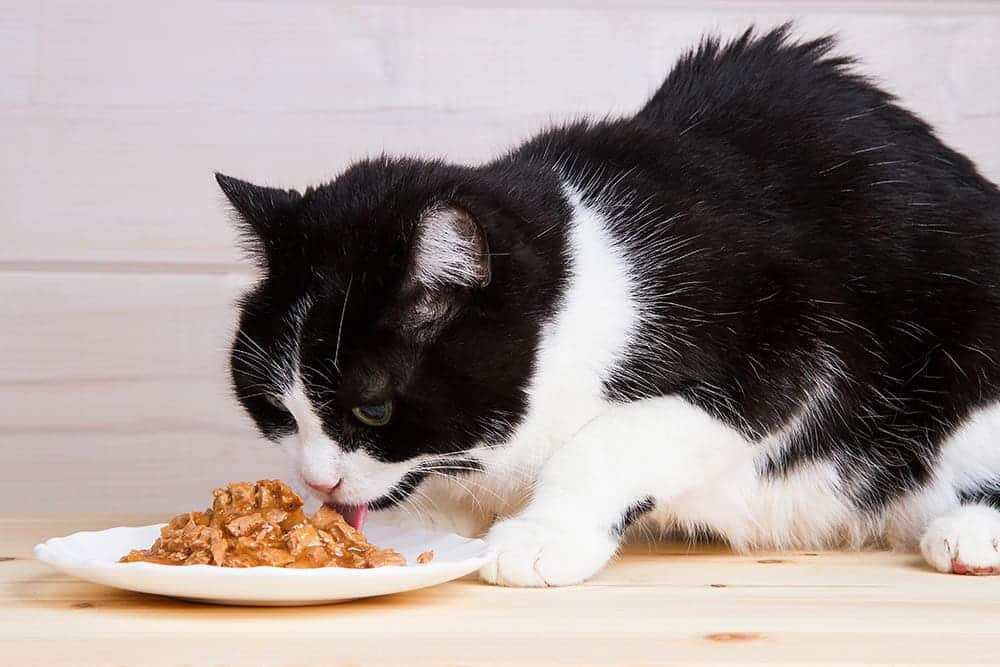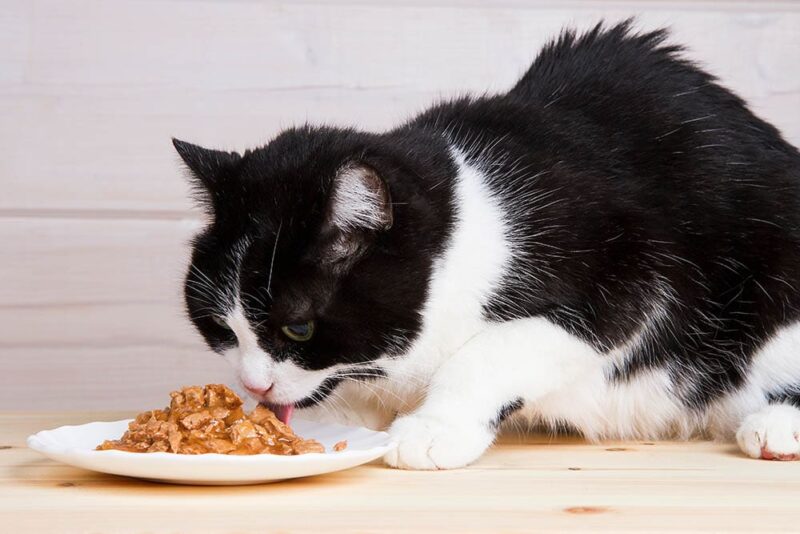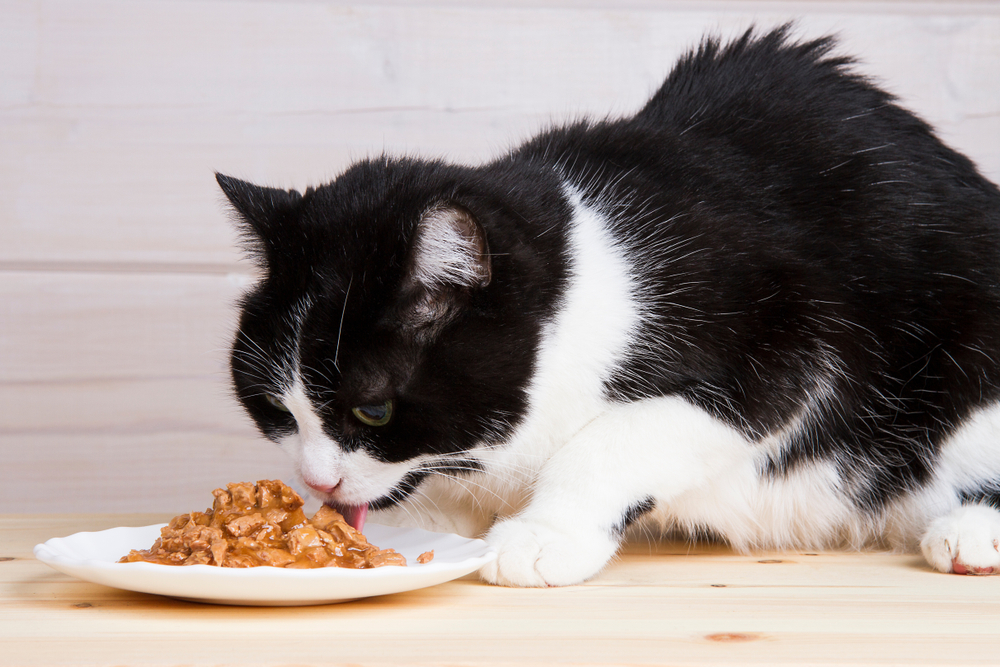
We believe that these products are representative of some of the best that are available. However, if your older kitty has specific health conditions, you may want to chat with your veterinarian before making a final decision.
A Quick Look at Our Winners of 2024
| Image | Product | Details | ||
|---|---|---|---|---|
| Best Overall |
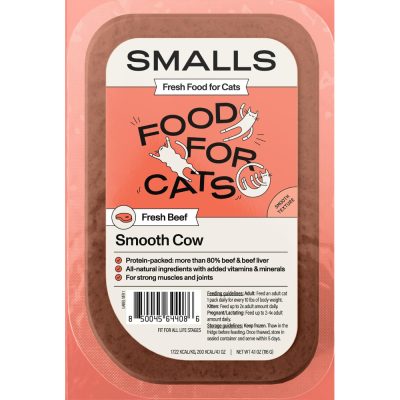
|
Smalls Fresh Smooth Cow Cat Food |
|
Click to Save 40% Use Code Catster24 |
| Budget Buy |
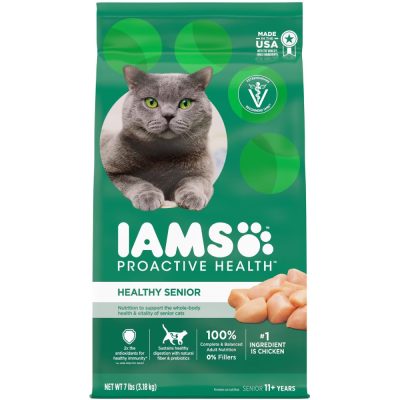
|
Iams ProActive Health Healthy Senior Dry Cat Food |
|
CHECK PRICE |
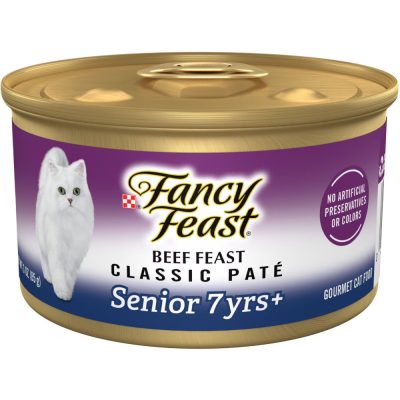
|
Fancy Feast Beef Feast Classic Pate Senior 7+ Canned Cat Food |
|
CHECK PRICE | |
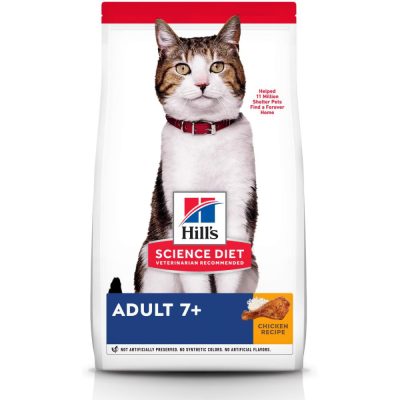
|
Hill's Science Diet Adult 7+ Chicken Recipe Dry Cat Food |
|
CHECK PRICE | |
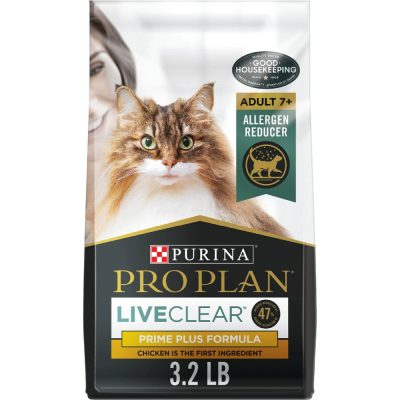
|
Purina Pro Plan LiveClear Formula Dry Cat Food |
|
CHECK PRICE |
The 10 Best Cat Foods for Senior Cats
1. Smalls Fresh Smooth Cow Cat Food – Best Overall
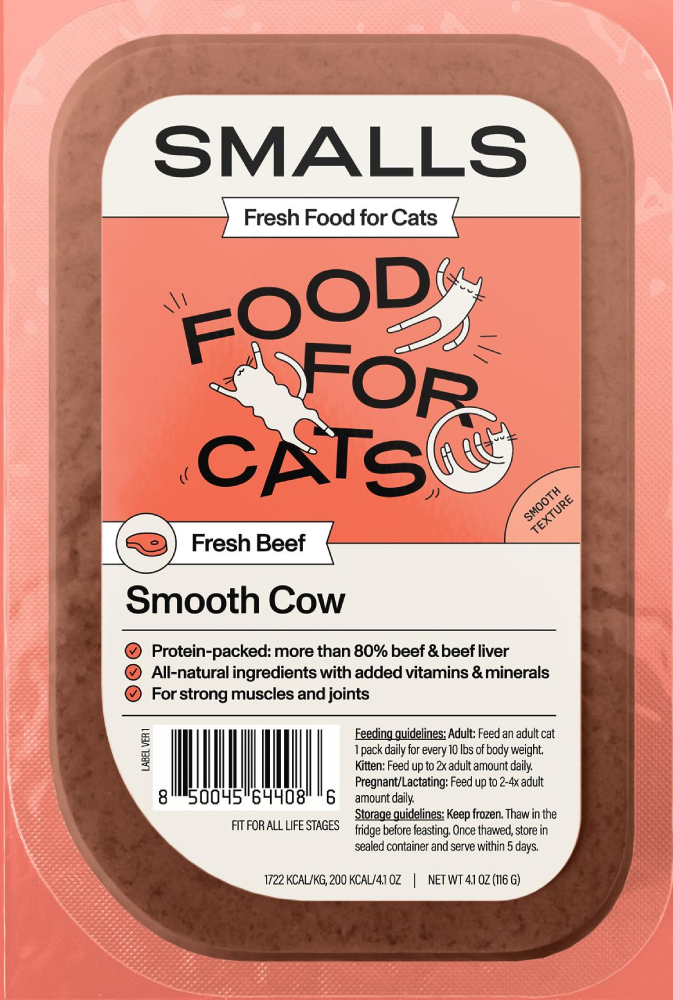
| Main ingredients: | Ground beef, beef liver, green beans, beef heart, water |
| Crude protein content: | 5% |
| Crude fat content: | 12% |
| Calories: | 200 kcal/4.1 oz |
Smalls Fresh Cat Food is our best overall pick. It could even be good enough for humans to eat. It is prepared with human food-grade standards imposed by the FDA and USDA using only the best quality fresh ingredients, as opposed to other cat foods, which are prepared with animal feed-grade standards.
Derived from all-natural animal protein and fresh vegetables, it contains no fillers, BPAs, or preservatives and uses only natural flavors and colorants. Ingredients are humanely harvested and sustainably sourced. Smalls Fresh Foods are prepared in either smooth or ground textures. This makes them particularly suitable for our golden oldies who may be experiencing dental sensitivities or even missing teeth.
Smalls Fresh Foods are available on a subscription basis only. There’s no need to decide what to feed each night, and the food is delivered to your doorstep.
- Subscription-based food service
- Fresh Food
- Contains taurine
- Reduced rate trial boxes available
- Perfect texture for cats with bad teeth
- High-quality animal protein, low in carbs and high moisture content
- Only available on subscription
- Fresh food requires uninterrupted refrigeration
2. Iams ProActive Health Healthy Senior Dry Cat Food – Budget Buy
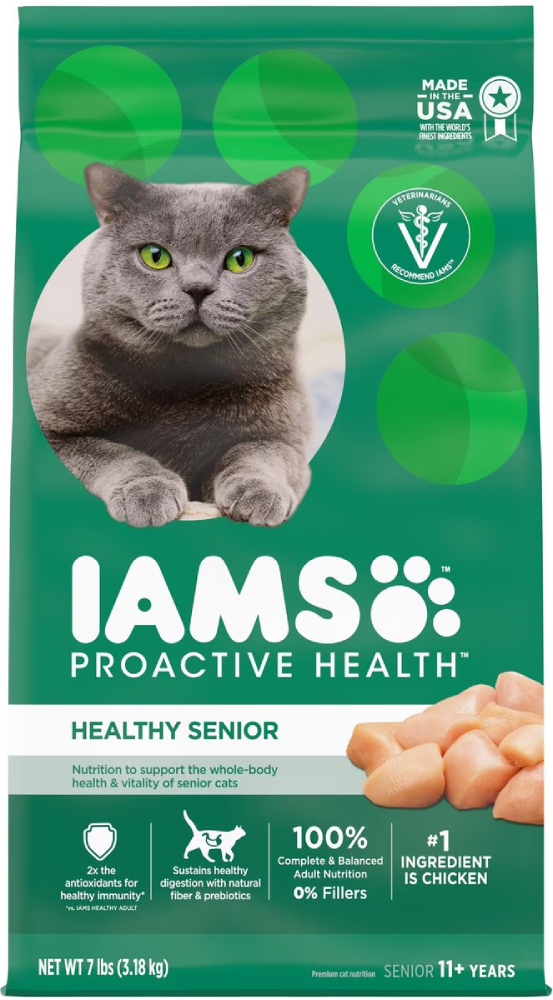
| Main ingredients: | Chicken, chicken by-product meal, corn grits, ground whole grain corn, dried plain beet pulp |
| Crude protein content: | 34% |
| Crude fat content: | 17% |
| Calories: | 399 kcal/cup |
Iams has been producing quality pet food for decades. This one is no exception and comes with a very affordable price tag. We think that Iams ProActive Health Healthy Senior is the best senior cat for your money.
It contains specially selected nutrient-dense ingredients for your senior cat. Fortified with calcium, phosphorus, and L-carnitine, ProActive is designed to keep your cat’s joints and muscles strong while maintaining a healthy weight. The addition of Vitamin E and anti-oxidants will give your kitty’s immune system a much-needed boost.
A disadvantage of ProActive is the presence of several filler-type ingredients. They are not devoid of nutrients but don’t add protein. However, the protein and fat content of Iams cat food is more than sufficient for an aging indoor carnivore.
- Value for money
- Contains real chicken
- Contains anti-oxidants and Vitamin E
- Formulated for strong bones and joints
- Contains L-carnitine for healthy weight maintenance
- Contains corn products
- May not be suitable for all cats
3. Fancy Feast Beef Feast Classic Pate Senior 7+ Canned Cat Food
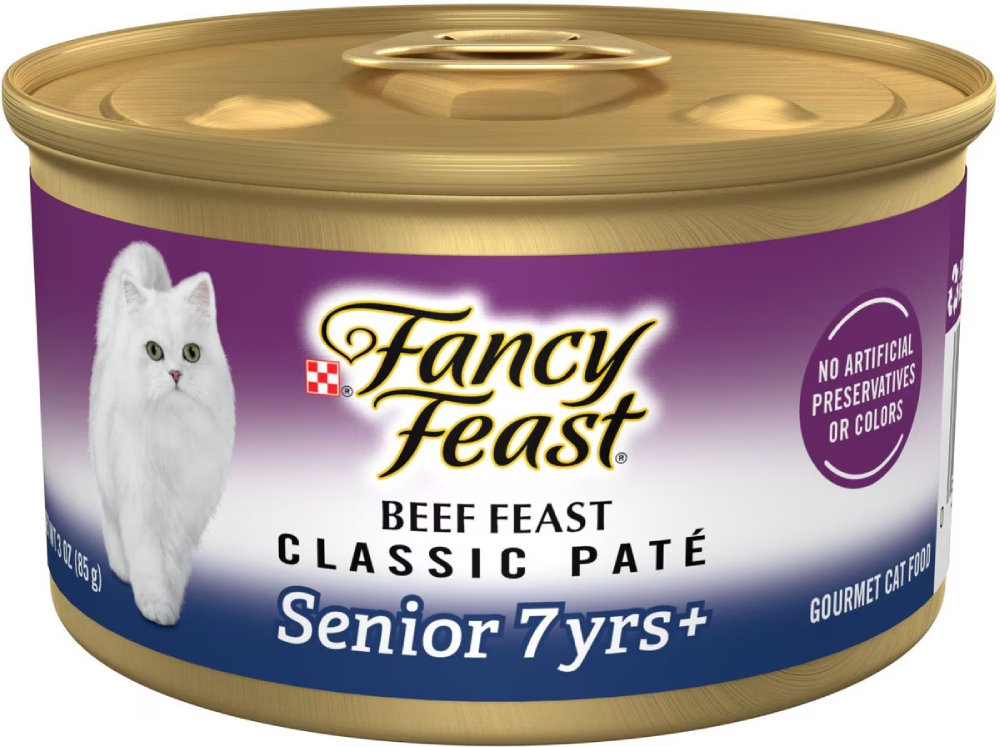
| Main ingredients: | Beef, fish, meat by-product, liver, beef broth |
| Crude protein content: | 5% |
| Crude fat content: | 5% |
| Calories: | 95 kcal/can |
For the kitty that loves her wet cat food, Fancy Feast Beef Feast Classic Pate will prove irresistible. The smooth, paté texture is easy to ingest and highly palatable. If your elderly kitty is missing some of her teeth or has dental sensitivities, this is a great choice for her.
The recipe includes much-needed anti-oxidants to boost immune function and the essential amino acid, taurine. It also contains vitamin E to keep her coat healthy and a host of other essential vitamins and minerals. The high moisture content from the beef broth will help keep her hydrated. Remember that wet cat food has a large moisture content, so you need to feed more than you would with dry food to obtain the same nutrient content.
- Mainly meat ingredients
- High in antioxidants and Vitamin E
- Source of taurine
- Affordable
- Unspecified meat “by-products”—could be anything
4. Hill’s Science Diet Adult 7+ Chicken Recipe Dry Cat Food
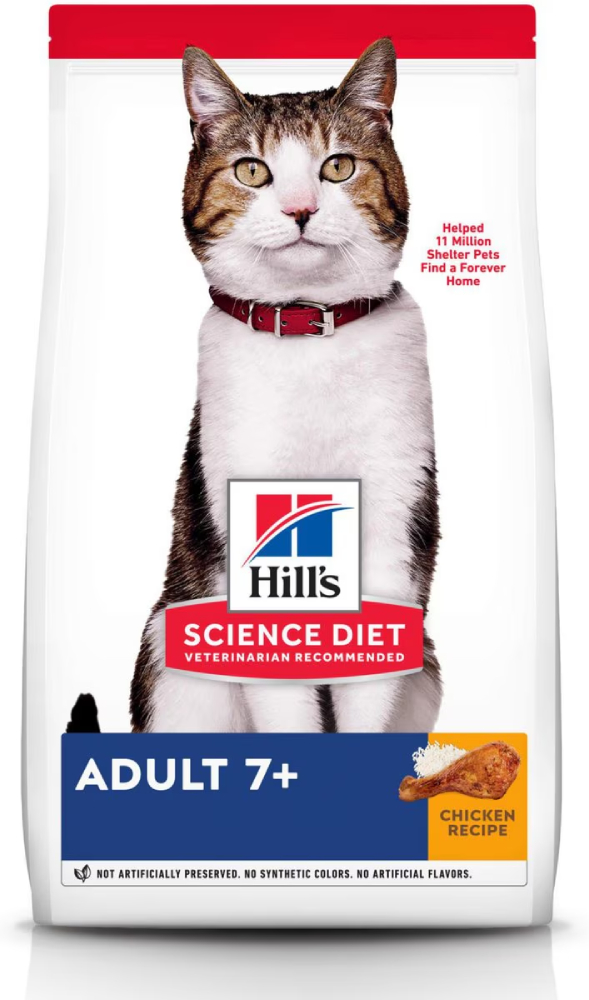
| Main ingredients: | Chicken, whole grain wheat, gluten meal, chicken fat, brewer rice |
| Crude protein content: | 27% |
| Crude fat content: | 16% |
| Calories: | 500 kcal/cup |
Hill’s Science Diet Adult 7+ Chicken Recipe is a US-made, fully balanced dry cat food. It is made with natural ingredients, and we like that the first ingredient on the list is chicken. It doesn’t contain any artificial colors, preservatives, or flavors. It’s jam-packed with vitamins, minerals, and antioxidants to support your aging cat’s bones, joints, skin, and immune system. It may fall into the more pricey range of cat foods, but it is worth every cent.
Bear in mind that it might not suit all felines due to several ingredients that may trigger allergies.
- Great formula, proven results
- Chicken as a whole-protein source
- Ingredients might not suit all cats
- Expensive
5. Purina Pro Plan LiveClear Adult 7+ Dry Cat Food
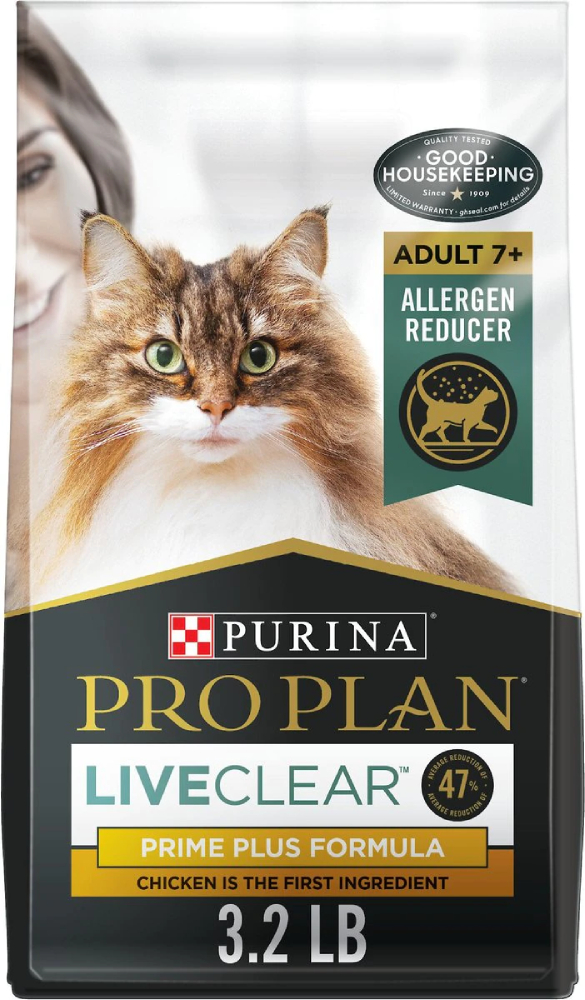
| Main ingredients: | chicken, poultry by-product meal, corn gluten meal, rice, cassava root flour |
| Crude protein content: | 38% |
| Crude fat content: | 17% |
| Calories: | 604 kcal/cup |
Purina Pro Plan LiveClear Adult is not only specially formulated for your older cat but also for the human allergy sufferers in their lives. It’s formulated using a special protein found in eggs, and it can neutralize one of the allergens that are found in cat saliva.
Purina Pro Plan LiveClear packs a nutritional punch, too. It has a high protein content and contains a host of necessary vitamins and minerals, as well as antioxidants. The recipe also includes live probiotics to assist with good gut health. It has a higher calorie count than most other dry cat foods and can help with weight gain for underweight felines.
With all of these incredible ingredients, one could be forgiven for overlooking the inclusion of a few questionable ingredients like cassava root flour and corn gluten meal.
- High beneficial protein and fat content
- Great for homes with human allergy sufferers
- Contains live probiotics
- Contains by-product meals and non-protein ingredients as main ingredients
- Expensive
6. Nulo Freestyle Senior Grain-Free Dry Cat Food
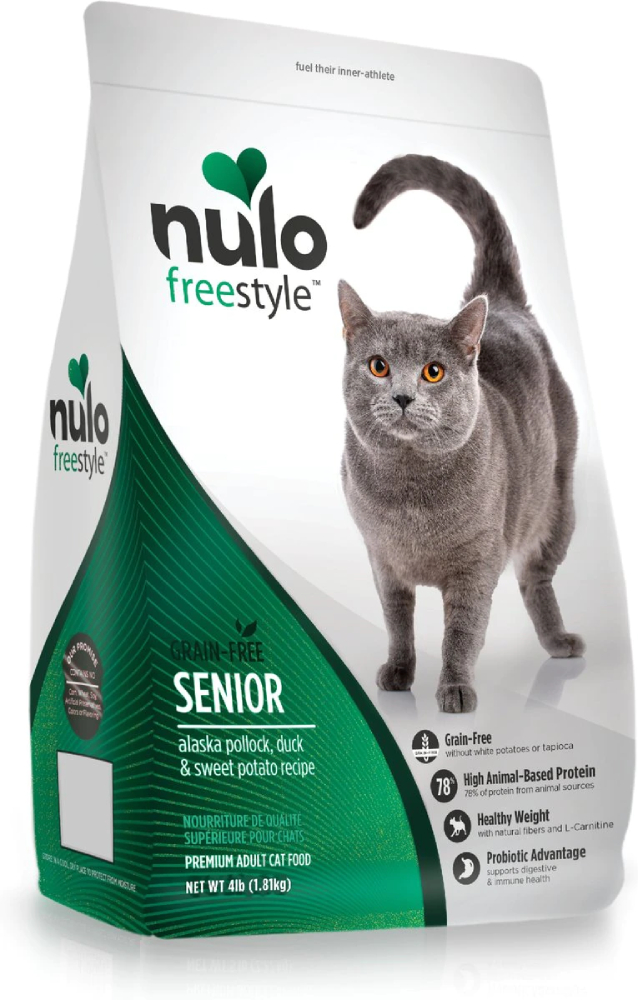
| Main ingredients: | Pollock, chicken meal, turkey meal, yellow peas, green lentils |
| Crude protein content: | 38% |
| Crude fat content: | 14% |
| Calories: | 431 kcal/cup |
Nulo Freestyle Senior Alaska Pollock, Duck & Sweet Potato Recipe is a great protein-rich senior cat food, with 78% of proteins being derived from animal sources. It’s high in fiber, L-Carnitine, and moisture, which helps support a healthy weight in kitties that may be bordering on the rotund. It is grain-free and contains omegas 3 and 6 for a healthy coat and optimal nerve function.
The recipe also includes probiotics and antioxidants, which assist with the maintenance of a healthy gut and immune system, respectively.
- 78% of proteins derived from animal sources
- Added probiotics
- Omega 3 and 6
- Pricey
- Some cats may find the kibble size too small
7. Royal Canin Feline Health Nutrition Aging 12+ Thin Slices in Gravy
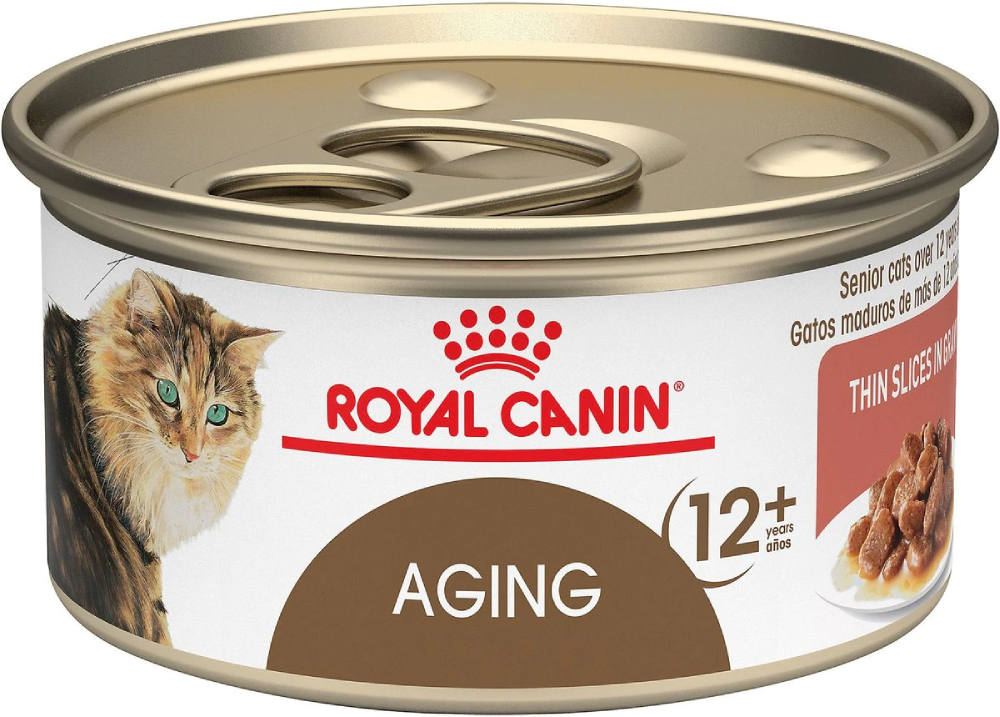
| Main ingredients: | Pork by-products, pork liver, chicken, chicken liver, water |
| Crude protein content: | 9% |
| Crude fat content: | 2.5% |
| Calories: | 71kcal/can |
The soft, wet slices in Royal Canin’s Feline Health Nutrition Aging 12+ wet cat food are the perfect texture for the older cat with failing teeth. It has been formulated with geriatric cats older than 12 years of age in mind. Omega 3 fatty acids support joint health, and controlled phosphorus levels support optimal kidney function. The increased moisture content in wet food is especially beneficial for older kitties that do not drink enough water. Royal Canin’s formula can be combined with dry kibble to ensure optimum nutrition.
- Wet food is extra hydrating
- Encourages fussy eaters
- Special formula for 12+ yr old cats
- Exclusive feeding could get expensive
- Main ingredient is by-product meat
8. Blue Buffalo Tastefuls Hairball Control Dry Food
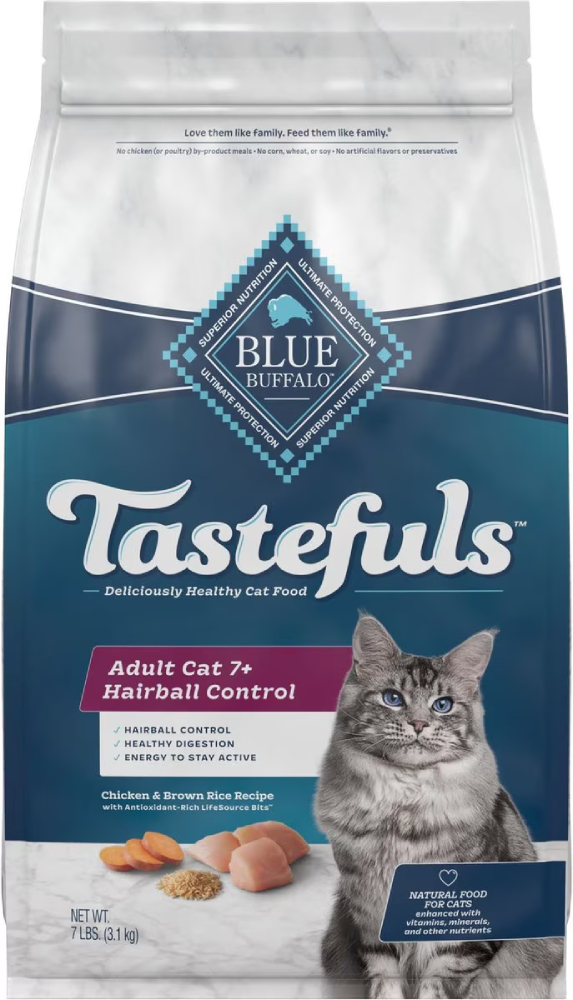
| Main ingredients: | Deboned chicken, chicken meal, brown rice, barley, oatmeal |
| Crude protein content: | 28% |
| Crude fat content: | 13% |
| Calories: | 397 kcal/cup |
Blue Buffalo Tastefuls Hairball Control has been formulated with the hairball-prone golden oldie in mind. Cats who are prone to hairballs are likely to remain so throughout their lives, though it may worsen with age as their digestive processes falter. Real chicken is the primary source of protein in the Blue Buffalo Hairball Control food for seniors.
The ingredients that help control hairballs are psyllium seed husks and cellulose. It also contains Blue Buffalo’s exclusive blend of minerals, vitamins, and antioxidants called “LifeSource Bits.” This blend helps keep bones, joints, and immune system functioning. The recipe is free from wheat, corn, soy, chicken by-product meals, preservatives, and artificial flavors.
- No added artificial flavors and preservatives
- Free from wheat, corn, soy, and chicken by-product meals
- Effective hairball control
- Some cats may be sensitive to some of the ingredients
9. Purina ONE Indoor Advantage Senior 7+ Cat Food
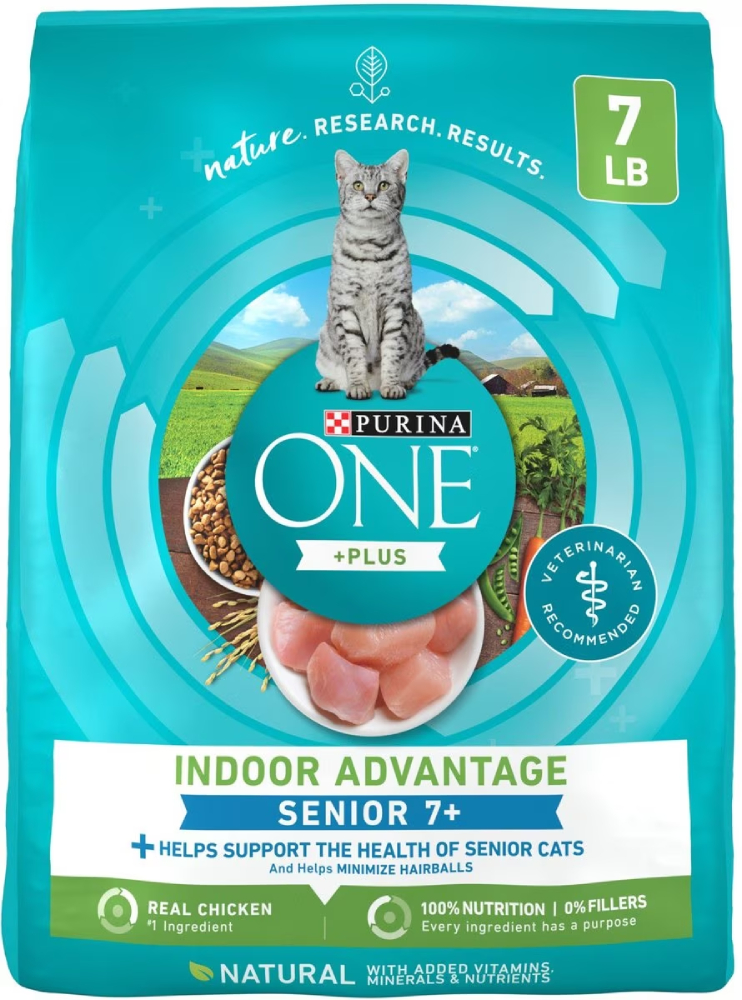
| Main ingredients: | Chicken, chicken by-product meal, rice, corn gluten meal, soybean meal |
| Crude protein content: | 36% |
| Crude fat content: | 13% |
| Calories: | 413 kcal/cup |
Despite containing several questionable ingredients (chicken by-product meal, corn gluten meal, soybean meal), Purina ONE Indoor Advantaged still provides high protein content from an animal source. It is packed with minerals, vitamins, antioxidants, and calcium. These all help keep bones, joints, teeth, and the immune system healthy. Purina ONE Indoor Advantage senior cat food also contains a natural fiber to assist with hairball control.
- Great value for money
- Contains no fillers, preservatives, or artificial flavors
- Loaded with vitamins, minerals, and antioxidants
- Contains several undesirable ingredients
- Formulated for indoor cats
10. Now Fresh Senior Weight Management Recipe Dry Food
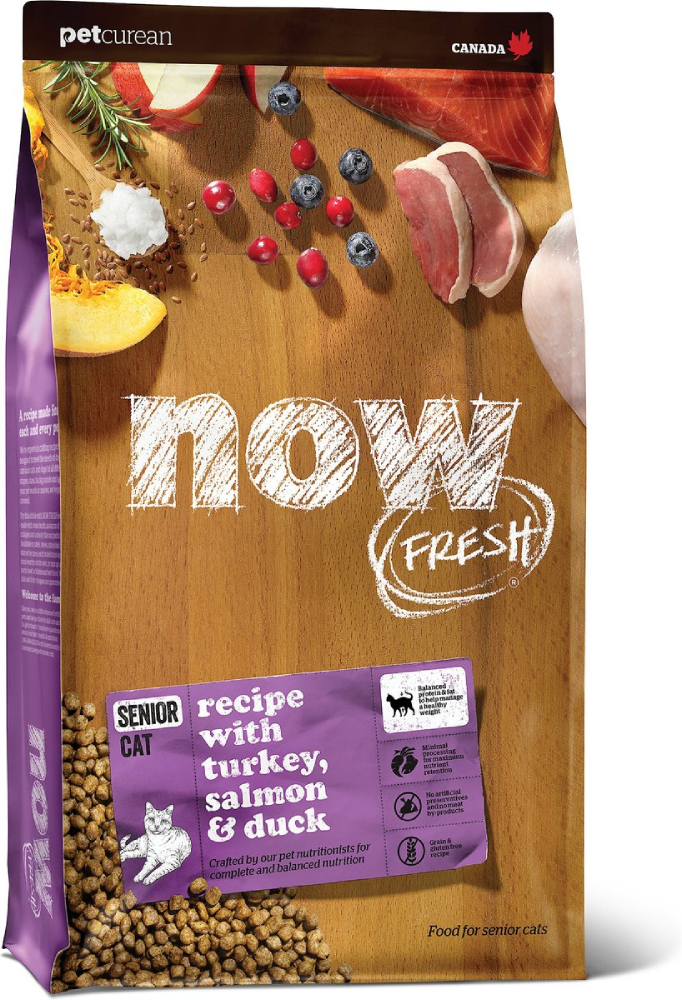
| Main ingredients: | De-boned turkey, potatoes, peas, pea fiber, potato flour |
| Crude protein content: | 38% |
| Crude fat content: | 14% |
| Calories: | 3889 kcal/cup |
Now Fresh Grain-Free Senior Weight Management Recipe has a modest protein and fat content to assist with weight control. It also contains L-Carnitine, which helps with fat burning while supporting the heart. The chief source of protein is whole turkey breast, and it contains no by-products or meat meals. It’s also free of artificial flavors, colors, and preservatives.
Now Fresh Grain-Free is full of all the essential vitamins, minerals, and antioxidants you expect in a high-quality senior cat food. It also contains a natural source of fiber in cranberries, which additionally offers support to the urinary tract.
- Helps with weight control in overweight cats
- Free from wheat, gluten, corn, soy, grains, artificial flavors, and preservatives
- Contains L-Carnitine
- Expensive
- Some cats find it unpalatable
Buyer’s Guide: Choosing the Best Cat Food for Senior Cats
Deciding to make the change to senior cat food for your beloved cat might be necessary at some stage. But it can be overwhelming once you discover the enormous variety of offerings available for middle-aged and geriatric felines. The first step is to understand what are the general health concerns that older cats tend to experience.
The second step is to gain a better understanding of which of these health concerns, if any, your kitty is beginning to experience. The last step, having identified your cat’s particular health needs, is to find a senior food that will best address these needs. Let’s explore these concepts in a little more detail.
Some Health Concerns In The Older Cat That Could Be Alleviated or Supported With an Appropriate Diet
Dental Issues
As your cat gets older, so do their teeth. Although dental disease is not specific to older cats (cats of all ages experience it), the longer they live, the more likely they experience it to some degree. They may lose teeth with age or develop painful cavities. Dental issues are agonizing and are exacerbated by certain foods.
Arthritis
That stiffness when your old cat gets up, or a reluctance to jump up on favorite perches are signs of arthritis. Arthritis is also a painful condition that many elderly cats develop, which can affect their quality of life.
Urinary Tract Issues
As cats age, their already low thirst response becomes even less active. This can lead to repeated or semi-constant dehydration and subsequent urinary tract issues.
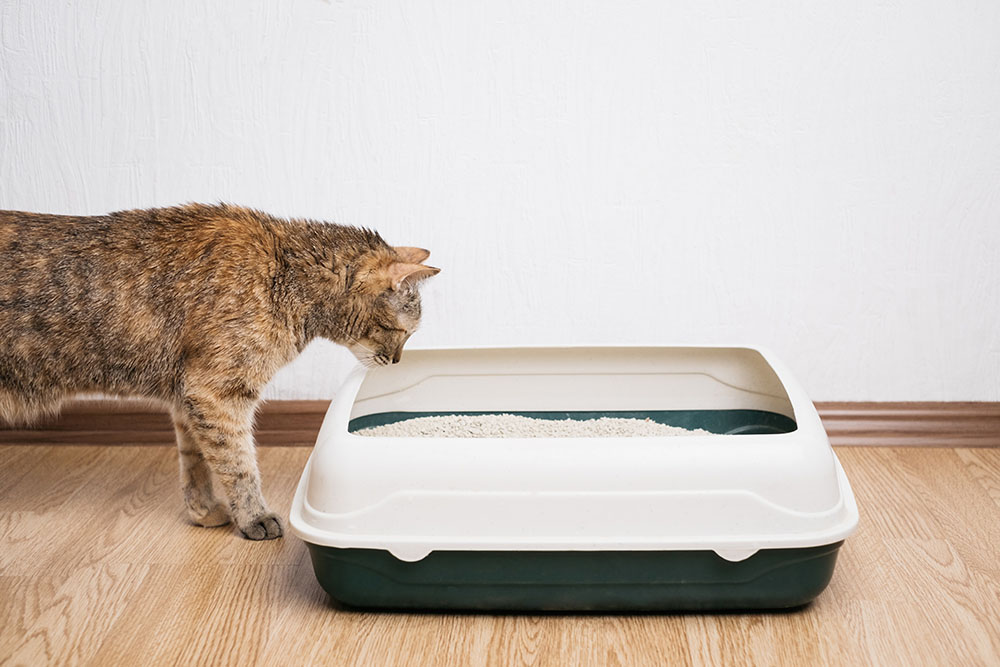
Diabetes
Cats that are not very active and are overweight run a higher risk of developing diabetes as they get older. If the diabetes is caught early on, it is possible to reverse it following intensive treatment. But once established, it will mean that your cat will have to have insulin injections for the rest of their life.
Kidney Disease
Kidney disease, sadly, is all too common in cats approaching their twilight years. Signs of kidney disease are weight loss, excess thirst, decreased appetite, more frequent urination, and a higher volume of urine. Vomiting may occur, too.
Weight Problems
Older cats may begin to pick up or lose weight. They might gain weight due to their metabolism becoming sluggish with age, decreased activity, and an unchanged appetite. On occasion, weight gain could be indicative of some other underlying condition, such as hypothyroidism.
On the other hand, an aging cat may begin to lose weight. This could be due to a loss of bone and muscle mass associated with aging or an underlying issue such as kidney disease or cancer.
Dietary Considerations for Your Geriatric Feline
If any of the previous conditions have been identified (by your veterinarian) in your elderly kitty, they may recommend making changes to their diet. In many of these conditions, this would be in addition to the prescription medications.
For example, cats with dental or urinary tract issues may do better with wet food. The high moisture content will assist with hydration issues associated with urinary tract problems. Soft, wet food is also more palatable for cats with painful or missing teeth.
Some diets are specially formulated to support renal patients, while others are more suitable for cats with diabetes. There are also cat foods available with ingredients supporting cats with arthritis. Many cat foods address weight problems in elderly felines, whether they need to lose or gain weight.
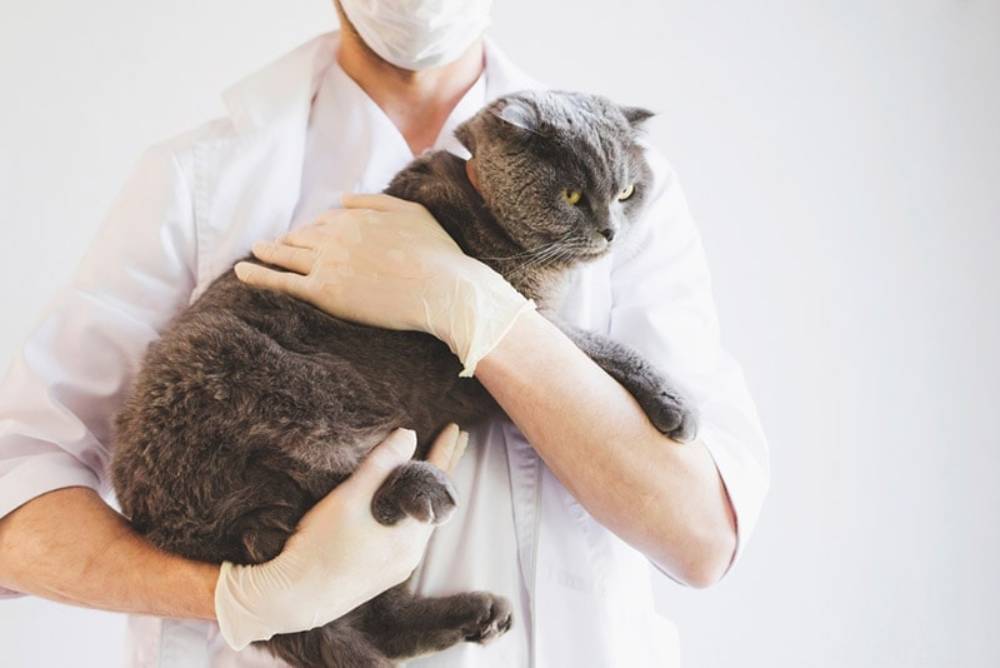
When Is the Right Time to Change to a Senior Cat Food?
There isn’t a single black-or-white answer to this question. It is 100% dependent on the individual cat. Some cats may thrive for their entire existence on one kind of cat food. That’s not to say they may not have benefitted from a food formulated for seniors, but they were just fine without it. Other cats begin to struggle as they near their twilight years, and for some, a diet change can be life-changing, provided the correct new food is chosen.
As you have seen, cat food manufacturers produce phase-appropriate wet and dry cat food. You could use these as a basic guideline as to when to switch food. As your cat transitions between their kitten, adolescent and adult phases, these guidelines are essential.
If you notice that your cat is no longer thriving as well as they used to, it’s time to look at making some changes. The first thing to do is to have them checked out by your veterinarian to ensure that no serious health issues need veterinary treatment. Then, you can discuss the benefits of switching to senior food and which would be best.
Conclusion
There is a huge range of senior cat foods available formulated for different situations and conditions. The trick is to find the one that best suits your cat and your pocket.
The one that stands out from the rest is Small’s Fresh Cat Food, as the best overall. There is no doubt that this food would satiate even the fussiest feline palate, but it might not suit every budget. For fur parents on a budget, Iams ProActive Health Healthy Senior Dry Cat Food represents the best value for your money while still keeping your elderly cat in tip-top shape.
We hope our reviews of the best cat foods for senior cats have helped you get closer to making a decision for your precious feline.
Featured Image Credit: Elizabett, Shutterstock
Contents
- A Quick Look at Our Winners of 2024
- The 10 Best Cat Foods for Senior Cats
- 1. Smalls Fresh Smooth Cow Cat Food – Best Overall
- 2. Iams ProActive Health Healthy Senior Dry Cat Food – Budget Buy
- 3. Fancy Feast Beef Feast Classic Pate Senior 7+ Canned Cat Food
- 4. Hill’s Science Diet Adult 7+ Chicken Recipe Dry Cat Food
- 5. Purina Pro Plan LiveClear Adult 7+ Dry Cat Food
- 6. Nulo Freestyle Senior Grain-Free Dry Cat Food
- 7. Royal Canin Feline Health Nutrition Aging 12+ Thin Slices in Gravy
- 8. Blue Buffalo Tastefuls Hairball Control Dry Food
- 9. Purina ONE Indoor Advantage Senior 7+ Cat Food
- 10. Now Fresh Senior Weight Management Recipe Dry Food
- Buyer’s Guide: Choosing the Best Cat Food for Senior Cats
- Some Health Concerns In The Older Cat That Could Be Alleviated or Supported With an Appropriate Diet
- Dietary Considerations for Your Geriatric Feline
- When Is the Right Time to Change to a Senior Cat Food?
- Conclusion

